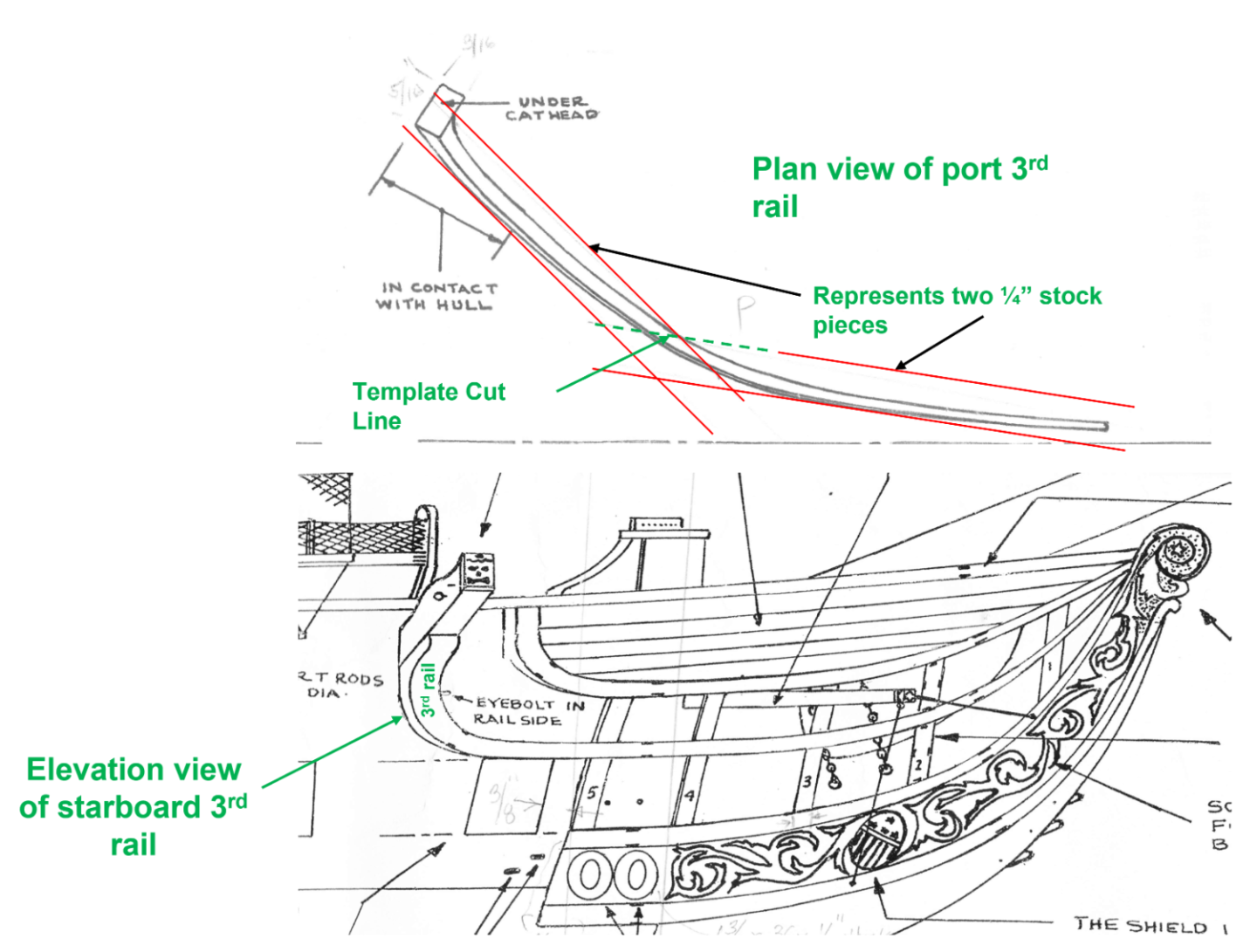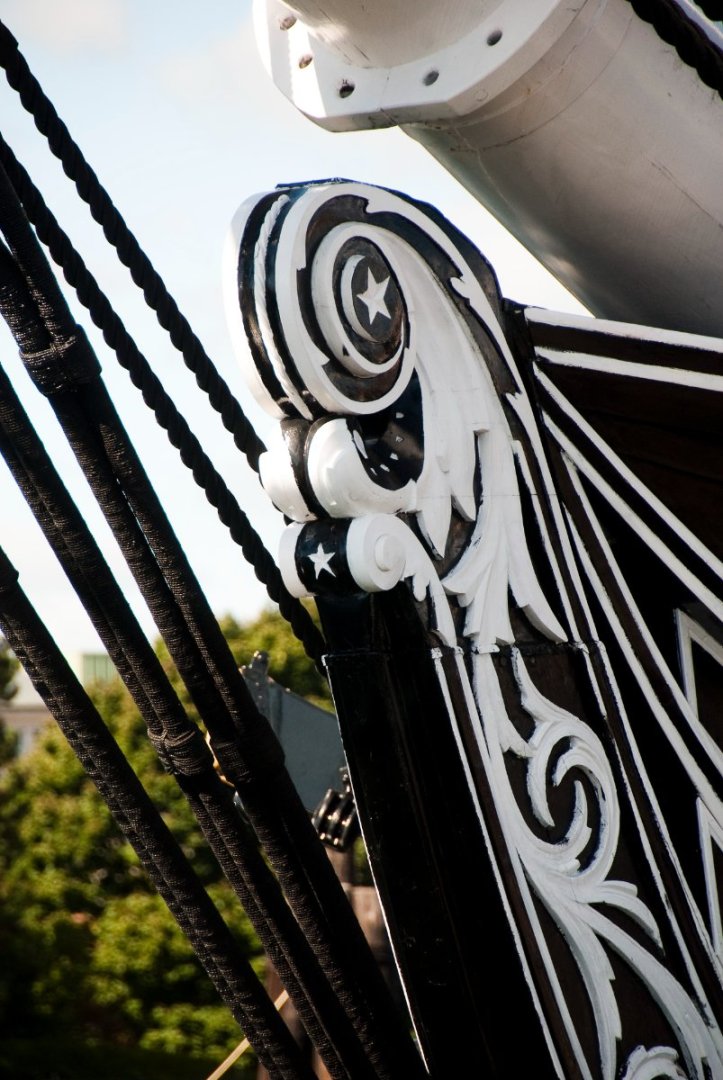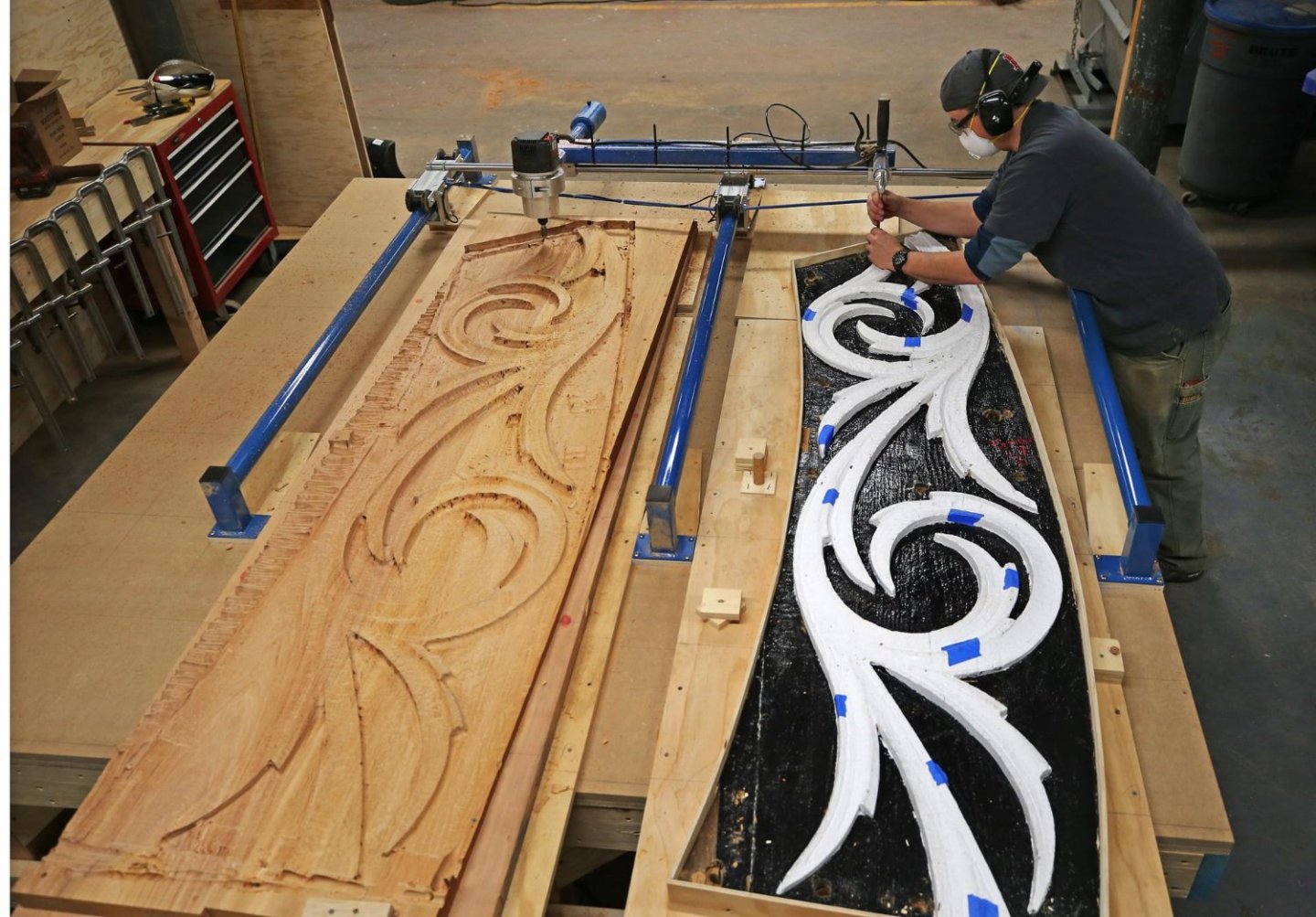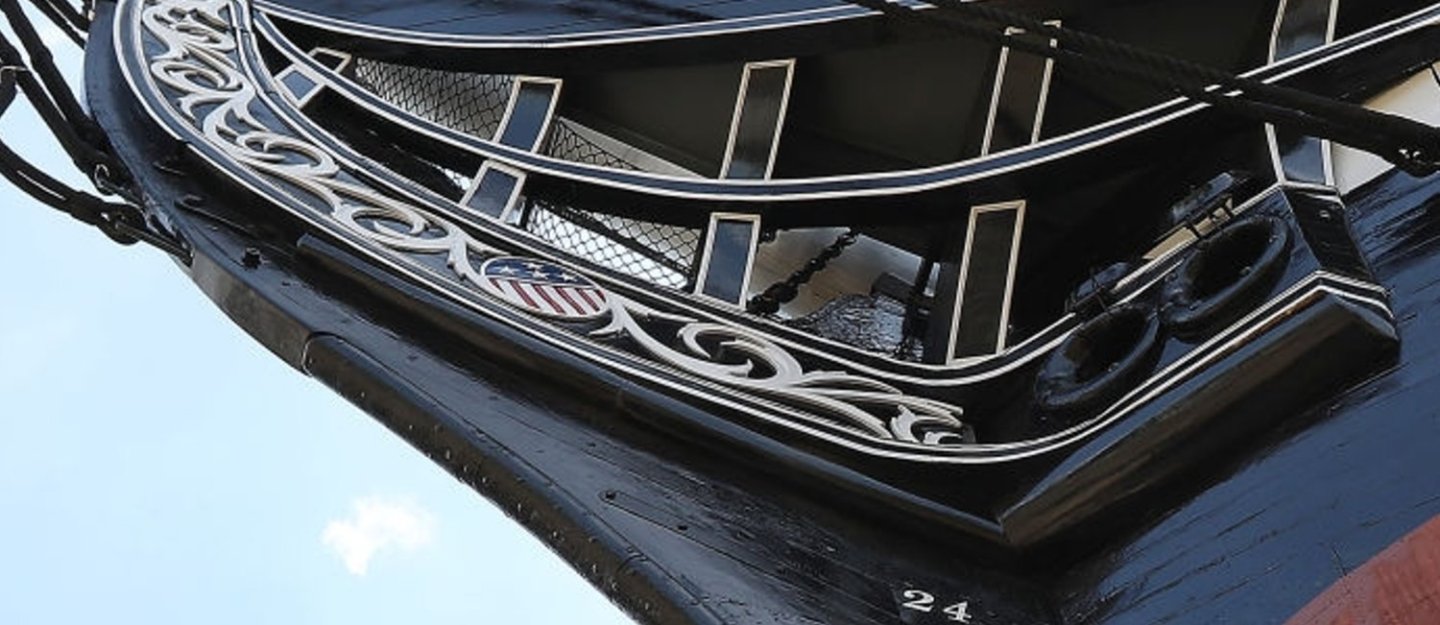-
Posts
2,606 -
Joined
-
Last visited
Content Type
Profiles
Forums
Gallery
Events
Everything posted by JSGerson
-
Very nicely done. If you show the bolt heads for the gun deck, shouldn't the spar deck have them as well? Those bolt heads represent the back end of the eye-bolts used for rigging the guns and there are guns on the top deck too. A bit late now. but another method for creating the bolt heads you could have tried, was using a needle point to dab fine drops of white glue onto the hull surface to create the bumps and saved you all the effort of drilling and cutting. Jon
-
By trial and error, piece by piece I fitted and refitted the parts with some symbolism of hope they would all fit together the way the plans showed them. Finally, when I felt it was a good as I was going to get, the rails were painted black and the pin striping was added. This time I used the 1/64” pin striping tape at the narrow portion of the rails and the 1/32” tape where it widened.
-
To complete the fabrication of the rails, the two components that made up each of the rails, were glued together. This had to be done on the faith that I fabricated the pieces perfectly so when they were attached together perfectly, they created the rails to perfectly fit on a perfectly formed hull. With my skills, I knew I hadn’t a chance of pulling this off on the first try. I made it sound straight forward, but it was not. I made numerous attempts and tried different methods to reconcile the process. To help me figure out where the rails had to fit, I cut out the five vertical rail supports out of 1/8” stock for each side of the bow. This presented its own set of problems. Although the rail supports were shown to be notched to accept the rails on the plans, I needed to know where the rails would touch the supports on the actual model. I couldn’t ensure that the rails were formed properly to fit into the supports until the supports were notched. And I couldn’t notch the supports until I knew where the rails would finally be in its proper position. What also hindered this process was, I couldn’t do dry fit ups because none of the parts were glued in place for the remaining parts to be dry fitted to. The rails hang out in space and needed to be connected to cantilevered support notches. When I attempted to at least hold the rails in position with my fingers, I found that the compound angles of the cathead cheek knee were not correct (surprise, surprise). To reconcile the compound angles, additional wood had to be added and original wood removed with sanding sticks and files in strategic areas on the cathead knee, to make the rails fit where they were supposed to go. I was sculpting the wood supports liked they were made out of clay. I could get away with this method because everything is to be painted black and no one will be able to see the multitude of pieces that make up the cathead knee. You can see where wood was added and carved off in the second image below.
-
The practicum calls for ¼” stock or 1/8” layered stock if you didn’t have the ¼” stock. Not having any ¼” stock at my immediate disposal, I glued and clamped two pieces of 1/8” stock, enough to make the two rails. Then as directed by the practicum, rubber cemented the images of the port and starboard rails from their fiddlehead tip to just where it turns upward to meet the cathead for the first rail component. The second component starts from under the cathead to where it overlaps the first to create a diagonal joint. I had to reapply the paper elevation and plan templates to the pieces that came from under the cathead so I could cut the wood in both the X and Y planes. Those parts curve in two directions. These are fragile pieces when they are cut out of the stock which made filing and sanding them to form their required shape, a delicate task.
-
The Cheek Knees and Rails Following the practicum again, I proceeded to the next rail, the one up from the trailboard or as the MS plans identify it, 3rd from the top. The practicum claims it’s “probably the most difficult of the rails to construct.” The reason is that the rails twists and turn in three dimensions, have no straight lines, tapers from one end to the other, and must connect to seven different points on the model precisely. The practicum’s method is to make the 3rd rail out of two main components as shown below, plus a third component, the cathead support called the cheek knee, that fits under the cathead sticking out 90 degrees with the cathead from the hull. This is because the rails’ complex shape would require very thick pieces of wood if the rails were to be carved as single units. The image below shows the MS plan’s elevation and plan views.
-
Avi, I didn't like the look of the MS kit provided scuppers once they were painted and installed. You couldn't see any detail and they basically vanished into the hull. According to the MS plans, the scuppers opened when water is flowing out of them, so they would normally be closed. However, when I looked at the photographs of the actual ship, they were open. So, I discarded the precast kit provided ones and made my own in the open configuration. You can see how I made them at posts #548 through #550. They weren't installed until post #630. Whether the results was worth my efforts, that's for you to judge. Jon
-
Beautifully done. I hope you plan on acquiring or building a case to protect the fruits of your labor. I know those cases aren't cheap, but they are worth the investment. I'm 5 years in, and still haven't completed the hull on my build, but I'll use your build as one of my sources to guide me going forward. Take that break, you deserve it. Jonathan Gerson
- 163 replies
-
- Model Shipways
- Constitution
-
(and 2 more)
Tagged with:
-

Looking for Rattlesnake instructions
JSGerson replied to rattle snake corvette's topic in Wood ship model kits
I also built the Mamoli Rattlesnake. The sheet plans have English, French, German and Italian translations on them. Some things that are not translated can be translated using Google or equivalent. I can provide you with two documents that may help you: Mamoli Parts List Translation which I created Reading-Decoding Mamoli Rigging Charts by Bill Edgin I hope these help Jon Mamoli List Translations.docx Reading-Decoding Mamoli Rigging Charts.docx -
Finally, the trailboards where glued into place. Then the hawsers were painted black and glued into position. Using my normal cordless drill with an 1/8” bit, the two openings in each howser were drill out into the interior of the model so that the future anchor chain and rope can pass through. The final touches were the white star and the braid on the front of the fiddlehead. The braid was made by twisting two strands of brass wire tightly, and then cutting the resulting piece to length. Two holes were drilled into the fiddlehead for each end of the braid to be inserted. Before the insertion, the braid was paint white. I should note that the thickness of my fiddlehead turned out to be thicker than the US Nay plans call for. Had I been aware much earlier on, the stem would have been tapered. But it is what it is.
-
Based on kmart’s idea (post 146), of the white architectural pinstriping tape, it is a lot easier to use than trying to work with very fragile narrow wood strip which must bend to the contour of the rails. 1/64” and 1/32” tape was purchased for the pinstriping of the bow. Only the 1/64” tape was used to pinstripe the trailboard. Additional white paint was used on the scroll work at the tip of the fiddlehead. Lucky, you can’t see all the imperfections that you do see in the magnified images.
-
The scroll boards spirals and stars were glued to the scroll board. The last element of the scroll board is the carved section right where the scroll board meets the hull as you can see is images below of the actual ship. This piece is actually attached to the hull and the scroll board and not just on the scroll board as the kit and practicum would have you install it. Therefore, that’s the way I fabricated and installed it. The short piece is mounted on a piece of 1/32” piece of wood. With one end one the scroll board and the other to be attached to the hull.
-
I also felt that the practicum’s styrene fiddlehead star was too big, another reason I didn’t follow the practicum for this detail. The star was made on the computer and printed on white paper. I thought about a decal, but the whole circle is only 3/32” in diameter and it had to be applied to a 3/32” diameter dowel. Because the star is white, the end of the dowel would have to be white, and the decal would provide the black markings to render the star image. Maneuvering a decal that small was going to be a bitch, so I chose to glue the paper to the dowel. It would then be cut off to a final height of about 5/64”. The images below show the brass spiral painted white (still needs a bit of touchup) and the paper white star and black background loosely in position for demonstration purposes.
-
That was the easy part. The fiddlehead was a bit more complicated. If you look at the actual ship’s fiddlehead below, it is a highly complex sculpture. I made several attempts to simulate the fiddlehead spiral using wood, styrene, and finally brass. I finally I settled on 1/32” x 1/32” brass rod. It could be bent into a very tight spiral without breaking, it was the right thickness, and I could make spiral open so the black background would show through. The last two images are the first rough shapes. You can see that I left a round opening for the central white star in a black circle.
-
The colored shield image was provided for a decal in the practicum, but good as they were, I decided to see if I couldn’t make my own from an actual image (shown below). The colors of this image were weather faded, so I had to use the computer to make the colors pristine. The image was cropped and reduced to scale size to create a decal. The wood shield piece had to be painted totally white before the decal could be applied.
-
Being my anal self, instead of using the kit supplied pattern for the carvings, I used the US Navy’s plans. 27498 - Billet Head sh1 30155001 - Bow Scroll Board I cut the paper patterns of the scroll board and rubber cemented them onto the 1/64” boxwood. So, I wouldn’t lose my way, I shaded in the scroll work with a pencil. Then using very, very fine etching bits (cone, ball, and rod) in my rotary tool, I cut the patterns out of the wood. All the unshaded areas were removed. The images below show the process and are just rough dry fits.
-
What’s been keeping me up all night is trying to figure out how to fabricate the carvings on the scroll board. I studied how other builders performed this task and it varied from using styrene (practicum), just painting the design, building up solder on a brass plate and carving the soft solder, etc. The carvings are basically flat and slightly proud of the base surface, so they do have some 3D dimension, which for me ruled out just painting the designs. Making the carvings out styrene as the practicum shows, bothered me because it was not wood, it’s too thick for the scale, and the styrene becomes very delicate when attempting to make fine detail cuts. xKen (post 322), who made his carvings out of brass plate and solder did a beautiful job, but the result I felt was out of scale in height above the base. I felt it was too thick. So, I finally chose 1/64” thick boxwood for most of the carvings. The photo below shows the flatness of the carvings, and any surface carvings are minimal, and shallow. At this scale they would be lost when the carvings are painted.
-
It’s been almost 2 months since my last update. I’ve been busy working on the model, but that’s not to say I accomplished much.in the first month. Again, with the false starts, restarts, hesitations, and wasting time, I did manage to fabricate and install the “support shelf” to the underside of the bottom trailboard rail. The rails themselves still were not installed at this time so I would have more freedom to work on the scroll board off ship.
-
Hi KMart, sorry I didn't get back to you earlier but I was out of town for a week visiting my sister for Thanksgiving and today I'm catching up on emails and such. The cathead figurine I bought is about 1/4" square which was based on the the laser cut cathead supplied by the kit and verified by the US Navy plans. The US Navy plans show the face of the "cat" to be 15 1/2" wide or 0.202" at 1:76.8 scale. At 1:75 scale, it's 0.206", so 1:75 is the scale you need to buy. Sorry about the price change. Jon
-
It's a mutual admiration society between us because I did take your idea for the architectural tape and bought some to do my pin striping which by the way is more accurate than using 1/32" styrene or wood. The MS plans shows the detail as 1/32" half rounds strips or about 2 1/2" full scale proud of the rail. But if you look at all the current images, those strips are flat and hardly rise above the rail surface. Good call. I'm still trying to figure how to form the fiddle head with the star a bit more realistic than what shows on the kit's laser cut part. Yours is spot on to what the kit shows. I'm a bit anal and am trying to do a bit more. So far, not much luck. If I fail, I'll try to make mine, look like yours. I'll be taking a break this week, visiting with my sister for Thanksgiving in Windsor Connecticut, a colonial section of Hartford. Have a good holiday. Jon
-
After numerous false starts, restarts, hesitations, and wasting time, I got the pieces partially glued together all the while measuring, remeasuring, checking and rechecking and still I had to do a bit of fudging to get it to this stage. I discovered from photos of the underside of the trailboard taken during the 2015-17 restoration, there was a “support shelf” (my term) that is not shown on the kit plans or installed by anyone else that I could find sufficient details on. I did not find a US Navy plan of the trailboard rail construction. The last image shows two pieces of 3/64” x 3/16” basswood stock per side that will be used to create the “support shelf.”
-
Most builders who documented their builds, created their trail boards from two pieces of wood using the profile in the plans. I couldn’t quite wrap my head what the final shape was supposed to look like or how to insure I had the proper dimensions. The rails bend in all three spatial dimensions. Also, I didn’t trust that my model truly matched the plans, so I used my as-built model and the photographs of the actual ship as my guides. The result was that instead of two pieces, I ended up with three (not counting fudge factor pieces): The rail on the stem, the hull, and the transitional curve between the two, which for me was the key piece. The angle where the trailboard meets the hull was measured using a profile gauge which was original transferred onto a piece of card stock to make a preliminary template which you can see in the first image below. Once I assured myself this would work, the process was repeated on 1/8” thick piece of stock basswood. A parallel line was drawn to it as well a parallel line to the basswood edge which would eventually represent the hull’ A curve was drawn representing the outer edge of the rail as it transitions from the stem to the hull. Satisfied, the process was repeated an additional three times so that a total of four transitions pieces were created: the upper and lower rails for each side of the hull. Based on the photographs, the upper transitional curves were a bit smaller than the bottom ones. Additionally, the hawser opens were constructed using the precast white metal parts from the kit. The back side (shown on the right accounts for the wale being proud of the hull. You’ll notice, my openings as seen from the front butt up against each other per the image from the actual ship and not the plans. In the image, the hawser assemblies have not been trimmed to their final dimensions at this point. Once installed, the hawser holes will be extended into the hull so that the anchor lines will be able to pass through them. The hull trailboard rails have not been constructed yet at this point.
-
The Head Rails – Trailboard Rails Using one of MS kit’s precut 1/32” thick trailboards as a template, two 1/8” thick trailboard bases were cut and carved from basswood stock. Next, four strips of 1/8” wide x 3/16” thick basswood stock were cut a bit longer than required for the upper and lower trailboard rails. The extra lengths facilitated the carving and bending. The rails tapered from 1/8” to 1/32” at the forward tip of the trailboard. Once the tapering was carved, they were soaked in water for a day and bent using the heating iron method. Then wetted again, they were clamped to the trailboards so that they would conform to their curves and final shapes when they dried.
About us
Modelshipworld - Advancing Ship Modeling through Research
SSL Secured
Your security is important for us so this Website is SSL-Secured
NRG Mailing Address
Nautical Research Guild
237 South Lincoln Street
Westmont IL, 60559-1917
Model Ship World ® and the MSW logo are Registered Trademarks, and belong to the Nautical Research Guild (United States Patent and Trademark Office: No. 6,929,264 & No. 6,929,274, registered Dec. 20, 2022)
Helpful Links
About the NRG
If you enjoy building ship models that are historically accurate as well as beautiful, then The Nautical Research Guild (NRG) is just right for you.
The Guild is a non-profit educational organization whose mission is to “Advance Ship Modeling Through Research”. We provide support to our members in their efforts to raise the quality of their model ships.
The Nautical Research Guild has published our world-renowned quarterly magazine, The Nautical Research Journal, since 1955. The pages of the Journal are full of articles by accomplished ship modelers who show you how they create those exquisite details on their models, and by maritime historians who show you the correct details to build. The Journal is available in both print and digital editions. Go to the NRG web site (www.thenrg.org) to download a complimentary digital copy of the Journal. The NRG also publishes plan sets, books and compilations of back issues of the Journal and the former Ships in Scale and Model Ship Builder magazines.












